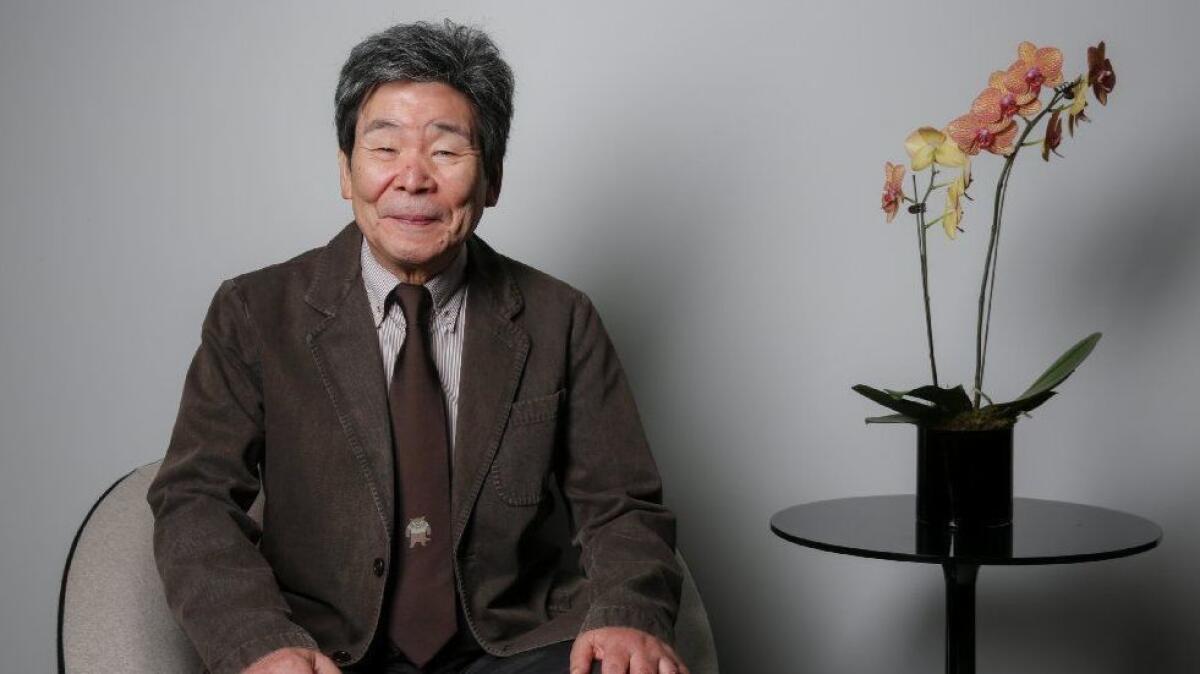Studio Ghibli co-founder Isao Takahata was a true poet of Japanese animation
In 1988, three years after they founded Japan’s celebrated Studio Ghibli, Isao Takahata and his friend Hayao Miyazaki unveiled one of the oddest double bills in animation history: “My Neighbor Totoro” and “Grave of the Fireflies.”
Even at this relatively early point in the careers of the two writer-directors, their strengths were clear: Miyazaki was the fantasist who would take viewers beyond their imaginations; Takahata, the poet who explored intimate, human moments with rare sensitivity.
Although Takahata, who died in Tokyo on April 5 at age 82, was a director of exceptional versatility whose work ranged from the earthy slapstick of “Pom Poko” to the gentle nostalgia of “Only Yesterday” to the fragile beauty of the Oscar-nominated “The Tale of the Princess Kaguya,” he remained best known for the heartbreaking poignancy of “Grave of the Fireflies.”
The film opens as the ragged, undernourished teen Seita collapses in Kokutetsu Sannomiya Station with the chilling words, “September 21, 1945 … that was the night I died.” In flashbacks, Takahata shows how Seita attempted to care for his younger sister, Setsuko, after they were orphaned in the American firebombing of Kobe, Japan, during World War II. The film suggests a flower on the grave of countless children who, like Seika and Setsuko, died needlessly in wars they neither fought nor understood.
The name Ghibli comes from a hot North African wind that blows into Italy; Miyazaki and Takahata wanted to blow fresh air into the Japanese animation industry, which they felt was stagnating. That sense of freshness was evident in Takahata’s later features, which were less devastating than “Fireflies,” but equally human.

In “Only Yesterday,” 27-year-old Taeko remembers her first conversation with a boy she liked and how they were too tongue-tied to utter more than a few awkward words. Takahata underscores the authenticity of the moment by having the watercolor backgrounds fade into the surrounding white paper, suggesting the incompleteness of memory.
Even Takashi, the blandly inept patriarch of the domestic comedy “My Neighbors the Yamadas,” has moments of reflection. Does Basho’s haiku about “A cicada trapped under a samurai’s helmet” really describe Takashi? He probably fears it does.
While Takahata’s films never quite broke through with U.S. audiences the way Miyazaki’s work (which includes “Spirited Away” and “Howl’s Moving Castle”) did, Takahata still exercised an outsize influence on American animators and live action filmmakers. Screenwriter Michael Arndt said, “I was inspired to finally sit down and write ‘Little Miss Sunshine’ — after years of procrastination — after seeing Takahata’s ‘My Neighbors the Yamadas’ at the [Museum of Modern Art] in New York in 2000.”
In many of his films, Takahata celebrated the beauty of the fields and forests of Japan, although he knew their existence was threatened. Finding life in Tokyo unsatisfying, Taeko returns to the countryside she visited as a girl; there she falls in love with the earnest farmer Toshio. Together, they will preserve a small corner of a countryside most young people have abandoned to live in cities.
The rowdy tanuki (raccoon dogs) in “Pom Poko” strive to protect from human developers the farms and woodlots of their home in the Tama Hills. But these celebrations of nature were restrained by the Japanese concept of “mono no aware,” an awareness of the inevitably transitory nature of life and beauty.
For his final film, Takahata adapted an ancient folk tale, “The Tale of the Bamboo Cutter,” as “The Tale of the Princess Kaguya.” The picture was Oscar nominated for animated feature in 2015. In an interview, he said, “I had no interest in displaying a 10th-century literary classic as if it were a picture scroll to be unrolled…. I wanted to tell the ‘true story’ of Princess Kaguya in a way that would be convincing to modern audience.”
As the film opens, an old man finds an infant no bigger than his thumb hidden in a stalk of bamboo. He and his wife lovingly care for the tiny child, who quickly grows into a ravishing beauty. They take her to the capital, where she attracts a string of high-born suitors. But she refuses them all after discerning flaws in their characters, just as she rejects the artificial refinement of urban life.
In a bid to regain her freedom, Kaguya flees the city for the country village where she grew up. The stately pace of the animation accelerates as the animators use rough brush lines to show her ripping off her finery to touch leaves and flowers. The striking sequence encapsulates Takahata’s rejection of the artificial, his love for nature and his abiding faith in human nature.
In his director’s statement, Takahata said, “I am not aiming to create a ‘fantasy’ by representing a finely detailed surface reality to enclose people in another world. Rather, I want to have people recollect the realities of this life by sketching ordinary human qualities with simple props. I want to have the wind blow freely between the reality of our daily lives and what we see in the film.”
In person, Takahata was quiet and soft-spoken, with a slightly melancholy smile. But his eyes were always alert, studying the people around him, observing the “ordinary human qualities” that made his films touch the viewer like a cool, welcome wind.
More to Read
Only good movies
Get the Indie Focus newsletter, Mark Olsen's weekly guide to the world of cinema.
You may occasionally receive promotional content from the Los Angeles Times.










